LnPulvRelBoth
Last updated: 2025-11-07
 Description
Description
Subassembly used to define pulverize and relay sections allowing for shoulder widening on both sides. Elevation of the attachment point is computed based on the elevation of the target surface between the width of the pulverization allowing for a minimum depth of pulverize.
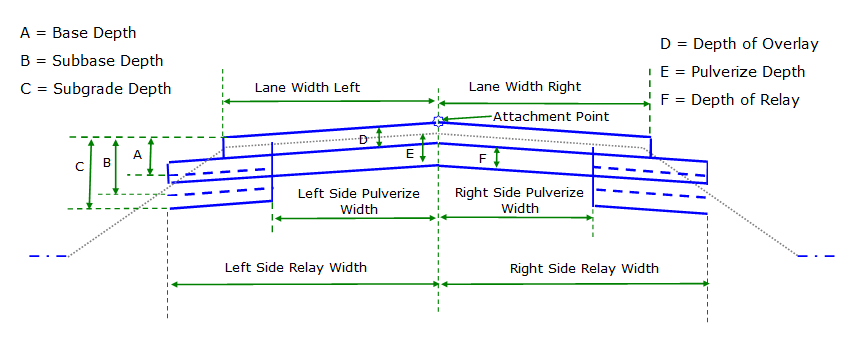
 Behavior
Behavior
This subassembly is used to define pulverize and relay sections allowing for shoulder widening on both sides. The horizontal location of the attachment point is indicated by the user, and the subassembly determines the elevation of the crown point by analyzing the Target surface at the Left Side Pulverize Width, the attachment point and Right Side Pulverize Width. The lowest elevation is computed using parameters set for the Pavement slopes and the Pulverize Depth parameter, which is the minimum depth of pulverize, measured down from the target surface. Once this low point has been determined, the bottom of the pulverize surface is defined used the Pavement slope parameters for right and left and the width of pulverize defined for the right and left.
The depth of the relay is computed using the following formula: Pulverize Depth * (Pulverize Width / Relay Width) * Pulverize/Relay Factor. If Left Side Pulverize Width is not equal to Right Side Pulverize Width, then the larger of the two values should be used in the calculation. If Left Side Relay Width is not equal to Right Side Relay Width, then the larger of the two values should be used in the calculation. The top of the relay surface is determined by measuring up from the bottom of the pulverize layer. The bottom of the relay surface is an extension of the bottom of the pulverize layer. Both the top and bottom of the relay surfaces are extended outward a distance defined by the Left Side Relay Width parameter and Right Side Relay Width parameter.
The top of the overlay surface (ie Top of Pavement) is computed by adding the Depth of the Overlay to the elevation at the top of the relay surface at the offsets defined by Lane Width Left and Lane Width Right. The overlay surface is drawn between the attachment point and the offsets defined by Lane Width Left and Lane Width Right, using the SE Slope or one that is user defined.
The cutout section on the left begins at the offset defined by the Left SidePulverize Width parameter. Layers defining the bottom of the first base course layer, second base course layer, and top of the subgrade surface are defined measuring down from the top of the overlay at these offsets. The Depth to Subgrade defines the depth of the bottom of the lowest base course layer. If the Base Depth entered is greater than the Subbase Depth entered, then Subbase Depth is equal to the Base Depth. If the Depth to Subgrade input is less than either the Base Depth or the Subbase Depth, then the Depth to Subgrade will be equal to the greater of the two values.
The cutout area on each side is defined by an essentially vertical link (slight offset from vertical so that surfaces can be created). On the left side, this link starts at the horizontal offset defined by the Left SidePulverize Width parameter on the Target surface and extends down to the top of the subgrade (defined by the Depth to Subgrade Parameter). On the right side, this link starts at the horizontal offset defined by the Right SidePulverize Width parameter on the Target surface and extends down to the top of the subgrade (defined by the Depth to Subgrade Parameter). On the left side, the base course link, subbase course link and top of subgrade link extend from this horizontal position outward to a distanced defined by the Lane Width Left parameter or the Left Side Relay Width parameter, whichever is greater, using the slope parameter defined for the subgrade. On the right side, the base course link, subbase course link and top of subgrade link extend outward to a distanced defined by the Lane Width Right parameter or the Right Side Relay Width parameter, whichever is greater, using the slope parameter defined for the subgrade. On both sides, all base course layers follow the slope of the subgrade. In addition, on each side from the top of the essentially vertical link, links are inserted inward, following the Target Surface, until reaching the attachment point.This allows for a closed shape to be created for the pulverize.
Ultimately on both sides, a link is drawn from the outside edge of the subgrade link to its intersection with the top of relay link, creating closed shapes to allow for quanitification.
This subassembly should be used with the shoulder rehab subassembly to complete the section.
 Attachment & layout mode operation
Attachment & layout mode operation
The attachment is at the crown point of the subassembly. Attachment point is typically at the assembly baseline point. Attachment point elevation is computed using Input parameters and the target surface.
In layout mode, this subassembly displays the overlay layer positioned from any convenient point of attachment at a slope of -2%. The subassembly is shown at the given widths and slopes.
 Description
Description
Info: All dimensions are in feet unless otherwise noted. All slopes are in run-over-rise form (for example, 4:1) unless indicated as a percent slope with a "%" sign.
| Parameter | Description | Type | Default |
|---|---|---|---|
| Lane Width Left | Specifies the lane width for the overlay to the left of the attachment point. | Numeric, Positive | 12.0 |
| Lane Width Right | Specifies the lane width for the overlay to the right of the attachment point. | Numeric, Positive | 12.0 |
| Depth of the Overlay (inches) | Depth of the overlay in inches. | Numeric, Positive | 6.0 |
| Base Depth | Distance from the top of the overlay to the bottom of the first base course layer. Outer limits of the base course links are defined by the lane width or the relay width, whichever is greater. | Numeric, Positive | 0.0 |
| Subbase Depth | Distance from the top of the overlay to the bottom of the second base course layer. Outer limits of the subbase course links are defined by the lane width or the relay width, whichever is greater. | Numeric, Positive | 0.0 |
| Subgrade Depth | Distance from the top of the overlay to the subgrade surface. If this parameter is set to 0.0, the FINGRD will follow the bottom of the pulverize surface from the outer limits of the pulverize width to the outer limits of the lane width or relay width, whichever is greater. | Numeric, Positive | 2.0 |
| Superelevation Type | Specifies whether the superelevation slope defined for the baseline alignment should be used, if it exists. Entry of Fixed, or if there is no baseline outside/inside lane superelevation values at this location, results in the Fixed Pavement Slope Left Side and Fixed Pavement Slope Right Side parameters being used; Entry of Use Outside Lane SE results in the left pavement slope being equal to the left Outside Lane Superelevation Slope for the defined baseline alignment and the right pavement slope being equal to the right Outside Lane Superelevation Slope for the baseline alignment ; Entry of Use Inside Lane SE results in the pavement slope being equal to Inside Lane Superelevation Slope for each side for the defined baseline alignment. |
String, Combo List of options: a.) Fixed b.) Use Outside Lane SE c.) Use Inside Lane SE |
Use Outside Lane SE |
| Fixed Pavement Slope Left Side | Fixed slope of the top of pavement link on the left side of the attachment point, used when the superelevation slope of the baseline alignment is not defined or specified not to be used. | Slope | -2% |
| Fixed Pavement Slope Right Side | Fixed slope of the top of pavement link on the right side of the attachment point, used when the superelevation slope of the baseline alignment is not defined or specified not to be used. | Slope | -2% |
| Subgrade SE Method | Specifies to the method used to determine the slope of the subgrade surface. |
List of options: a.) Use Outside Lane SE b.) Use Inside Lane SE c.) Follow Slope of Top of Pavement d.) Fixed Slope |
Use Outside Lane SE |
| Subgrade Slope Left Side | Default cross slope of the top of the subgrade surface on the left side of the attachment point. This value is used if Fixed Slope is selected as the Subgrade SE Method or superelevation is not specified for the baseline alignment. | Slope | -2% |
| Subgrade Slope Right Side | Default cross slope of the top of the subgrade surface on the left side of the attachment point. This value is used if Fixed Slope is selected as the Subgrade SE Method or superelevation is not specified for the baseline alignment. | Slope | -2% |
| Left Side Pulverize Width | Distance to outside edge of pulverize on left side. Measured from the attachment point. | Numeric, Positive | 10.0 |
| Right Side Pulverize Width | Distance to outside edge of pulverize on right side. Measured from the attachment point. | Numeric, Positive | 10.0 |
| Pulverize Depth | Minimum depth to the bottom of the pulverize layer. Measured down from the Target Surface. | Numeric, Positive | 0.75 |
| Left Side Relay Width | Distance to the outer edge of the relay on the left side, measured from the attachment point. | Numeric, Positive | 15.0 |
| Right Side Relay Width | Distance to the outer edge of the relay on the right side, measured from the attachment point. | Numeric, Positive | 15.0 |
| Pulverize/Relay Factor | Depth of relay is computed using the following formula: Depth of Relay = Pulverize Depth * (Pulverize Width / Relay Width) * Pulverize/Relay Factor. This depth is measured up from the bottom of the pulverize. | Numeric, Positive | 1.15 |
 Target parameters
Target parameters
This section lists the parameters in this subassembly that can be mapped to a target object such as a surface, alignment, or profile object in a drawing. For more information, see Setting and Editing Targets in the AutoCAD Civil 3D User's Guide Help.
| Parameter | Description | Status |
|---|---|---|
| Target Surface | Surface used to close the cutout area and to determine bottom of pulverize layer. The following object types can be used as targets for specifying the surface: surfaces. | Required |
| Lane Width Left | Object used to define the lane width to the left of the attachment point for the overlay. Object must be located to the left of the attachment point. The following object types can be used as targets for specifying the width: alignments, polylines, feature lines, or survey features. | Optional |
| Lane Width Right | Object used to define the lane width to the right of the attachment point for the overlay. Object must be located to the right of the attachment point. The following object types can be used as targets for specifying the width: alignments, polylines, feature lines, or survey features. | Optional |
| Left Side Pulverize Width | Object used to define the width to pulverize on the side left of the attachment point. Object must be located to the left of the attachment point. The following object types can be used as targets for specifying the width: alignments, polylines, feature lines, or survey features. | Optional |
| Right Side Pulverize Width | Object used to define the width to pulverize on the side right of the attachment point. Object must be located to the right of the attachment point. The following object types can be used as targets for specifying the width: alignments, polylines, feature lines, or survey features. | Optional |
| Left Side Relay Width | Object used to define the relay width on the side left of the attachment point. Object must be located to the left of the attachment point. The following object types can be used as targets for specifying the width: alignments, polylines, feature lines, or survey features. | Optional |
| Right Side Relay Width | Object used to define the relay width on the side left of the attachment point. Object must be located to the right of the attachment point. The following object types can be used as targets for specifying the width: alignments, polylines, feature lines, or survey features. | Optional |
 Output parameters
Output parameters
| Parameter | Description | Type |
|---|---|---|
| Left Pavement Slope | Slope of the Top of Pavement for Left Side Lane. | Slope |
| Right Pavement Slope | Slope of the Top of Pavement for Right Side Lane | Slope |
| Left Subgrade Slope | Slope of the Subgrade Surface to the Left of the attachment point. | Slope |
| Right Subgrade Slope | Slope of the Subgrade Surface to the right of the attachment point. | Slope |
| Base Depth Left | Base1 Depth at outer Edge on leftmost side computed by taking the difference between the elevation at ETW_Left and ETW_Base1_Left | Numeric |
| Base Depth Right | Base1 Depth at outer Edge on rightmost side computed by taking the difference between the elevation at ETW_Right and ETW_Base1_Right | Numeric |
| Subbase Depth Left | Base2 Depth at outer Edge on leftmost side computed by taking the difference between the elevation at ETW_Left and ETW_Base2_Left | Numeric |
| Subbase Depth Right | Base2 Depth at outer Edge on rightmost side computed by taking the difference between the elevation at ETW_Right and ETW_Base2_Right | Numeric |
| Depth to Subgrade Left | Depth to Subgrade at outer Edge on leftmost side computed by taking the difference between the elevation at ETW_Left and ETW_Sub_Left | Numeric |
| Depth to Subgrade Right | Depth to Subgrade Surface at outer Edge on rightmost side computed by taking the difference between the elevation at ETW_Right and ETW_Sub_Right | Numeric |
| Depth to Top of Relay Left | Depth to the Top of Relay Surface at the leftmost outer edge. Computed by measuring down vertically from ETW_Left to the TopRelay link. | Numeric |
| Depth to Top of Relay Right | Depth to the Top of Relay Surface at the rightmost outer edge. Computed by measuring down vertically from ETW_Right to the TopRelay link. | Numeric |
| Offset of ETW_Sub_Left | Offset of the leftmost outer edge of the subgrade surface. This offset is distance from baseline. If offset is to the right of the baseline, then it is a positive value, if it is left of the baseline, it is a negative value. | Numeric |
| Elevation of ETW_Sub_Left | Elevation of the leftmost outer edge of the subgrade surface. | Numeric |
| Offset of ETW_Sub_Right | Offset of the rightmost outer edge of the subgrade surface. This offset is distance from baseline. If offset is to the right of the baseline, then it is a positive value, if it is left of the baseline, it is a negative value. | Numeric |
| Elevation of ETW_Sub_Right | Elevation of the rightmost outer edge of the subgrade surface. | Numeric |
| Offset of ETW_Left | Offset of the edge of the top of pavement, left side. This offset is distance from baseline. If offset is to the right of the baseline, then it is a positive value, if it is left of the baseline, it is a negative value. | Numeric |
| Offset of ETW_Right | Offset of the edge of the top of pavement, right side. This offset is distance from baseline. If offset is to the right of the baseline, then it is a positive value, if it is left of the baseline, it is a negative value. | Numeric |
 Coding diagram
Coding diagram
Right side mirrors that shown below for each coding diagram.
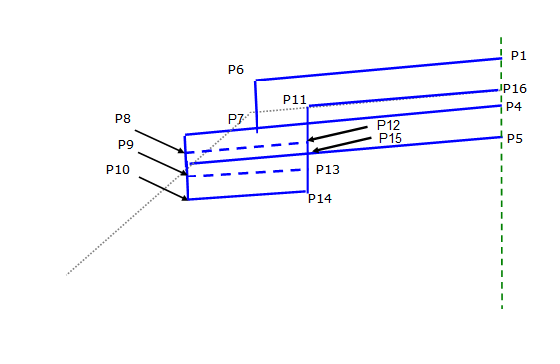
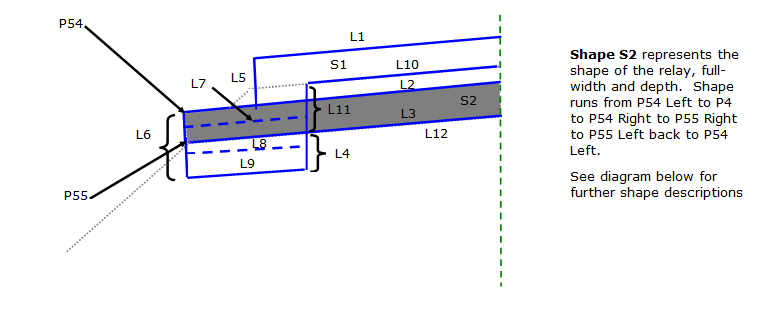
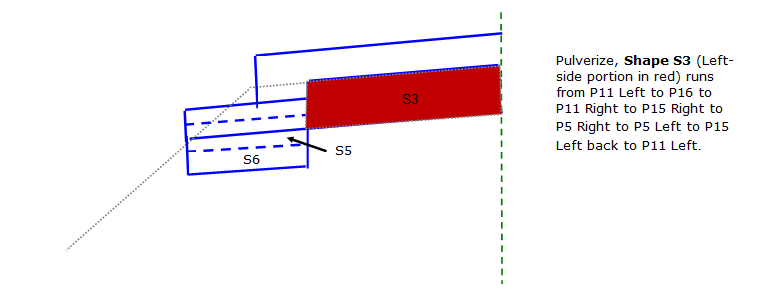
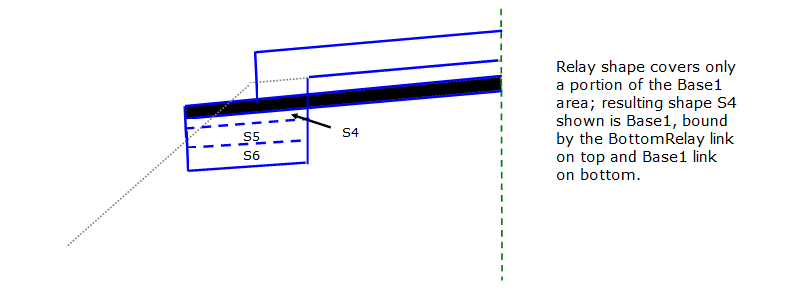
When Depth to Subgrade = 0.0
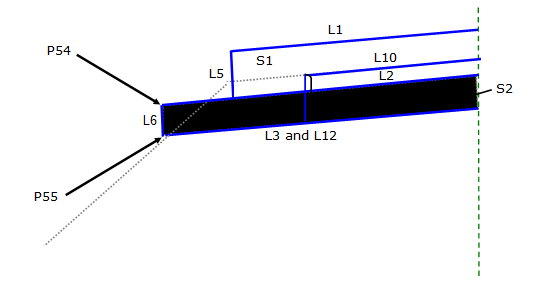
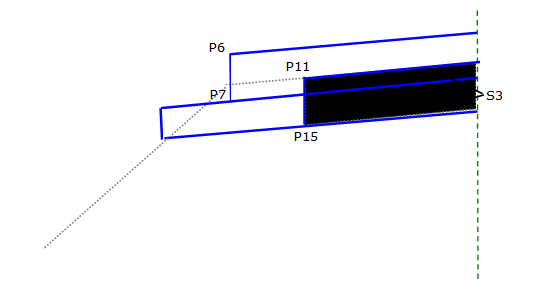
 Point, Link, and Shape codes
Point, Link, and Shape codes
| Point/Link/Shape | Codes | Description |
|---|---|---|
| P1 |
Crown CL |
|
| P4 | TopRelay_In | Inside edge of the top of the relay surface. |
| P5 | BottomRelay_In | Inside edge of the bottom of the relay surface. |
| P6 |
ETW_Left or ETW_Right |
Outside edge of overlay at the top of the pavement. |
| P7 |
ETW_Pave1_Left or ETW_Pave1_Right |
Outside edge of overlay at the bottom of the pavement. |
| P8 |
ETW_Base1_Left or ETW_Base1_Right |
|
| P9 |
ETW_Base2_Left or ETW_Base2_Right |
|
| P10 |
ETW_Sub_Left or ETW_Sub_Right |
|
| P11 |
Cutout_Left or Cutout_Right |
Top inside edge of Cutout; named with Right or Left depending on side |
| P12 |
Cutout_Base1_Left or Cutout_Base1_Right |
Cutout edge of bottom of first base course layer. |
| P13 |
Cutout_Base2_Left or Cutout_Base2_Right |
Cutout edge of bottom of second base course layer. |
| P14 |
Cutout_Sub_Left or Cutout_Sub_Right |
Cutout edge of top of subgrade. |
| P15 |
Pulv_Out_Left or Pulv_Out_Right |
Outside Edge of the bottom of the Pulverize. |
| P54 |
TopRelay_Out_Left or TopRelay_Out_Right |
Outside Edge of the Top of the Relay Surface |
| P55 |
BottomRelay_Out_Left or BottomRelayOut_Right |
Outside Edge of the Bottom of the Relay Surface |
| L1 | PaveLn1 | |
| L2 | TopRelay | Top of Relay Surface |
| L3 | BottomRelay | Bottom of Relay Surface – Links from Point P5 to Point P55 (Left and Right) |
| L4 | DatumSUBGSubbaseCutout | |
| L5 | ||
| L7 | Base1 | Bottom of first base course layer. |
| L8 | Base2 | Bottom of second base course layer. |
| L9 | DatumSUBGSubbaseCutout | Subgrade Surface |
| L10 | Pulverize | |
| L11 | Cutout | |
| L12 | DatumSUBGSubbase | Runs concurrently with a portion of BottomRelay from point P15 to point P5 (same thing on right side). |
| S1 | Pave1 | |
| S2 | Relay | Area of Relayed Material. Shape runs from P54 Left to P4 to P54 Right to P55 Right to P55 Left back to P54 Left. |
| S3 | Pulverize | Area of Pulverize |
| S4 | Base1 | |
| S5 | Base2 | |
| S6 | Subbase |